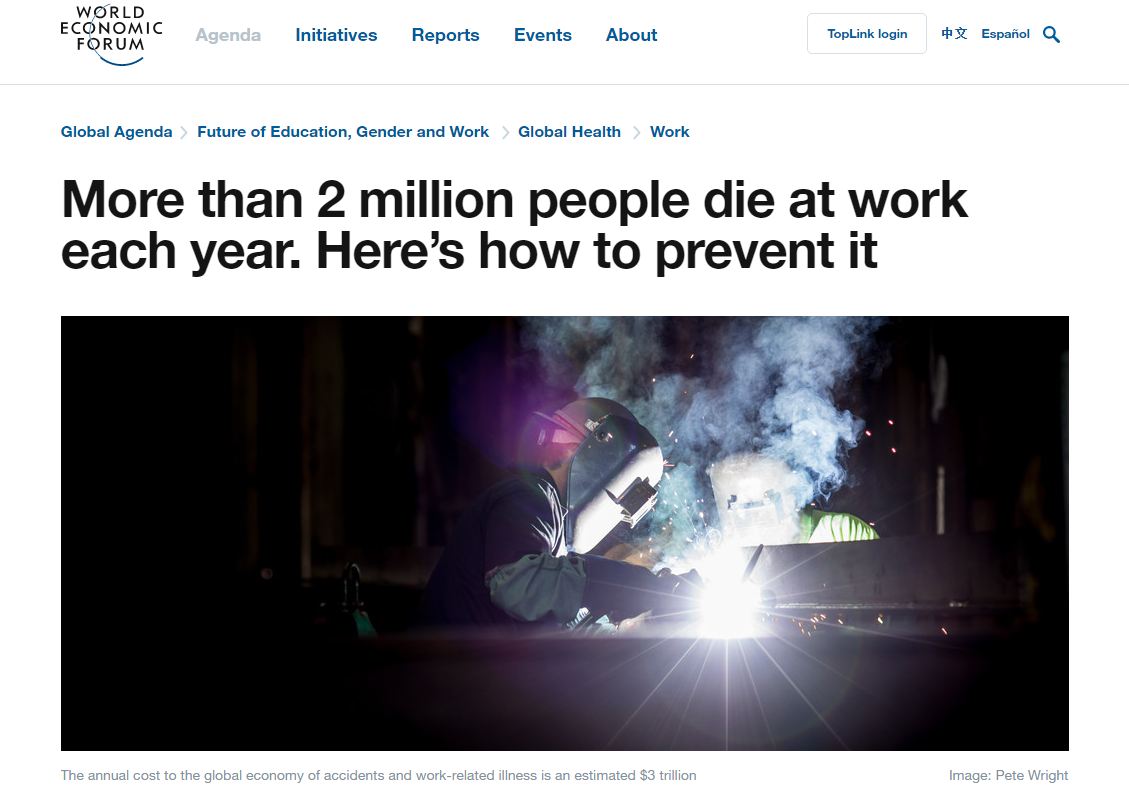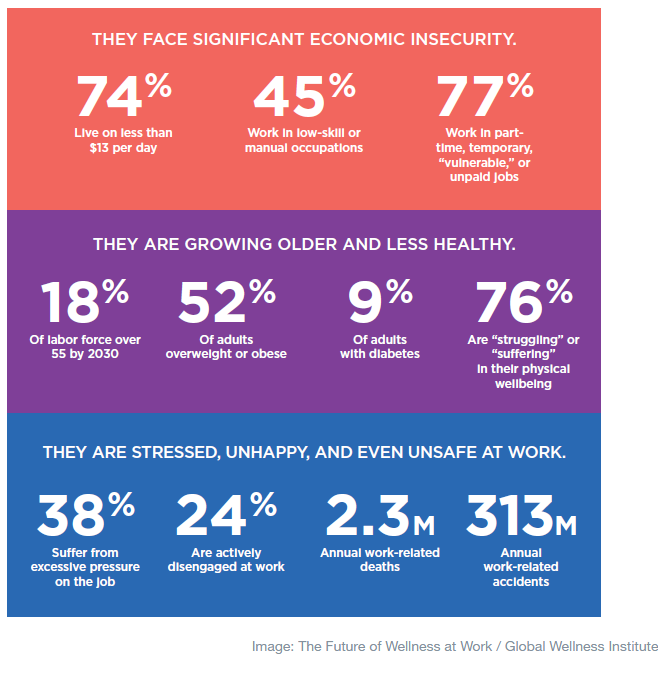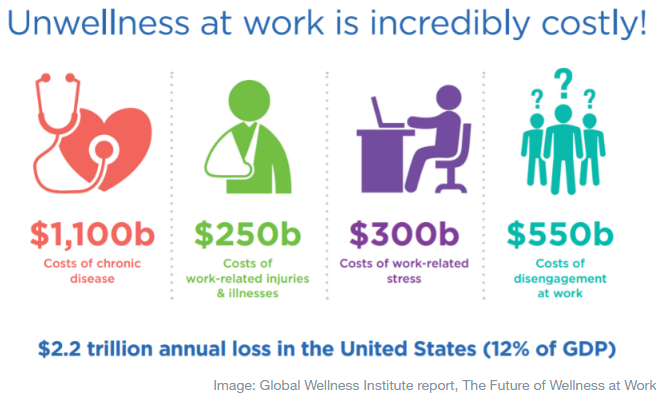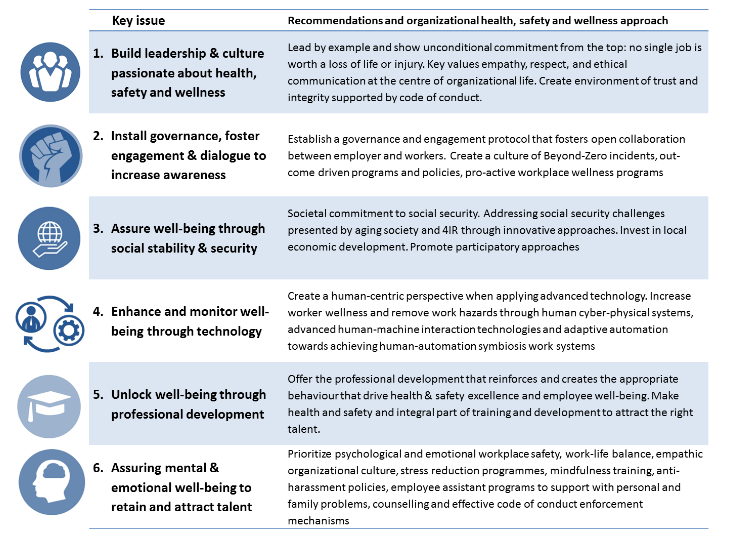More than 2 million people die at work each year. Here is how to prevent it
[edit] Introduction
According to the International Labour Organization (ILO), more than 2.3 million workers die every year as a result of occupational accidents or work-related diseases.
To put this number in perspective, across the world 167,000 people died in armed conflicts in 2015, according to the latest edition of the IISS Armed Conflict Survey. In addition to this astounding number, each year 313 million accidents occur on the job resulting in extended absences from work.
The ILO estimates that the annual cost to the global economy from accidents and work-related diseases alone is a staggering $3 trillion. Moreover, a recent report suggests the world’s 3.2 billion workers are increasingly unwell, with the vast majority facing significant economic insecurity: 77% work in part-time, temporary, 'vulnerable' or unpaid jobs.
What’s more, the labour force is growing older and less healthy: 52% is overweight or obese and 38% suffer from excessive pressure on the job.
[Image: The Future of Wellness at Work / Global Wellness Institute]
In addition to the social and human costs of health problems and fatalities, the cumulative economic burden caused by a lack of wellness at work is enormous for both businesses and the global economy. This is especially true when productivity losses are added to direct medical expenses.
A lack of wellness in the labour force is estimated to cost the global economy between 10 to 15% of global GDP. In the US alone, work-related injuries, illnesses and stress, and workers’ disengagement are estimated to cost the economy more than $2.2 trillion a year.
[Image: Global Wellness Institute report, The Future of Wellness at Work]
In 2013, Klaus Schwab, Founder and Executive Chairman World Economic Forum, introduced the Forum’s Workplace Alliance Report. He pointed out the importance and economic implications of workplace wellness:
“Employers have a great responsibility to nurture employee resilience; there is strong evidence that a healthy workforce is vital to a country’s competitiveness, productivity and well-being. Over 50% of the working population spend the majority of their time at work, so the workplace provides a unique opportunity to raise awareness, as well as guide and incentivise individuals to develop healthier lifestyles. This has proven to have a multiplier effect, as workers integrate health and well-being into their families and communities.”
The causes of safety and health problems vary by sector. In the urban economy, for example, approximately one in six fatal workplace accidents reported globally takes place in the construction sector. This is mainly because of the intrinsically hazardous nature of this work, the challenging locations of construction sites, changing work environments and high rates of staff turnover. There are also health problems associated with building activities, such as musculo-skeletal disorders and exposure to hazardous substances, such as asbestos.
[edit] ‘Zero incidents’ goals
The construction industry has, however, come a long way in preventing accidents and health problems. Within the industrial construction environment, both contractors and owners have to commit the time, budget and management to focus on the well-being of the construction workforce.
Contractors are not only obliged to provide statistical proof of acceptable safety performance, but also programmes and processes that promote the safety of every worker in their care. This prerequisite for a safety culture has allowed the industry to change from injury management to injury prevention and the creation of 'zero incidents' goals.
This is reflected in a recent report by Ernst & Young called The Future of Health and Safety – Moving beyond Zero:
“In many workplaces, safety is managed as a separate process, largely disconnected from the business imperatives of production and profit. However, health and safety is not a process in its own right, but an outcome of business decisions, strategy, culture and performance.”
The following six key areas for health, safety and wellness have been proven to create the kind of culture and environment that saves lives and increases overall worker welfare:
[edit] Creating an organisational leadership structure that fosters a culture passionate about health, safety and wellness
Ultimately, an organisation’s culture should ensure that its workers go home safe and healthy, while also satisfied from a good day’s work and proud of what they have achieved. To assure physical well-being, there can only be a zero-tolerance approach with respect to occupational health and safety issues.
The key is to set the right example: an organisation’s leadership has to demonstrate that no single job is worth a loss of life, injury or disease. They have to place key values – such as empathy, respect and ethical communication – at the centre of the organisation, while creating an environment of trust and integrity, perhaps via a clear, effective and enforced code of conduct.
[edit] Establishing governance, engagement and dialogue for health, safety and wellness awareness
It is important to establish a governance and engagement protocol, with open collaboration between employer and workers to discuss and address problems, and proactively channel grievances.
By asking workers to engage in steering committees, action teams and observation teams, they will not only identify and prevent hazards, but will generate a feeling of a protective organisation.
[edit] Well-being through social stability and security
The right to social security is recognised as a human right reflected in the societal commitment to the Universal Declaration of Human Rights:
“Everyone, as a member of society, has the right to social security and is entitled to realisation, through national effort and international co-operation and in accordance with the organisation and resources of each state, of the economic, social and cultural rights indispensable for his dignity and the free development of his personality.”
To ensure the well-being of an organisation’s labour force, it is paramount to address the social security challenges presented by an ageing society, as well as the emerging consequences of digital and technological progress, in a sustainable way.
Innovative approaches that promote inclusive growth, reduce income inequality, introduce alternative social security models (basic income, for example) will ensure that future employment will contribute substantially to the well-being of humanity.
[edit] Well-being through advanced technology
While there are many possible implications of new technology for labour, with respect to safety and health it is possible to anticipate a number of opportunities. Advanced technologies could indeed increase worker wellness by removing work hazards and easing physical exertion.
In the context of elderly workers, these technologies could include a so-called 'super-strength operator', where a human being wears a powered, flexible and mobile exoskeleton.
Other examples of human-machine interfaces are: augmented and virtual operators; healthy operators, such as wearable health sensors and trackers; smart operators connected to intelligent personal assistants (IPA); collaborative operators, who train and work with collaborative robots; social operators, who tap into a business’s online networking services; as well as analytical operators, who use big data analytics.
As these advances in technology continue, there are already innovations that can be applied today, allowing workers to not only remove or protect themselves from hazardous circumstances, but also to potentially become more efficient. All construction industries have the opportunity to advance the use of technology and, as a result, make workforce engagement safer.
[edit] Well-being through professional development
There is a mutual reinforcement between professional development, on the one side; and safety and health, on the other. First, it is important that safety and health is included as an integral part of training schemes throughout professional careers. At the same time, improved safety and health will help companies attract talent.
To be successful in attracting the right talent, offering flexibility and a sufficient work-life balance are essential. Bill Gates explains how businesses can benefit: “The competition to hire the best will increase in the years ahead. Companies that give extra flexibility to their workers will have the edge in this area.”
Therefore, to attract the best talent with the right skill set, a healthy work environment combined with a wellness culture becomes increasingly important.
[edit] Specific actions for ensuring mental and emotional well-being
We often underestimate the importance of psychological and emotional health in the workplace. Mental and emotional well-being is essential to overall health: positive mental health allows people to realise their full potential, cope with the stresses of life, work productively and make meaningful contributions to their communities.
The employer can proactively contribute by providing the necessary work-life balance, creating an empathetic organisational culture, offering stress-reduction programmes, implementing anti-harassment policies and supporting family leave, among many other things.
It’s worth it. After all, in the words of John Dineen, former President and Chief Executive Officer of GE Healthcare: “In today’s economic environment, facilitating the development of effective employer health strategies is a smart investment.”
Following the ILO’s Guideline 71 of the Internal Governance Documents System, the views expressed by an officer in an external publication are her/his and do not necessarily reflect the views of the International Labour Organization.
Written by
- Mark Brown, Vice President, Construction & Fabrication, Fluor Corporation
- Michael Buehler, Head of Infrastructure & Urban Development, World Economic Forum
- Edmundo Werna, Head of Unit at the Sectoral Policies Department, International Labour Organisation (ILO)
The views expressed in this article are those of the author/s alone and not the World Economic Forum.
This article was originally published on the Future of Construction Knowledge Sharing Platform and the WEF Agenda Blog.
[edit] Find out more
[edit] Related articles on Designing Buildings Wiki
- Environmental health.
- International Infrastructure Support System (IISS).
- Risk assessment.
- Thermal comfort and wellbeing.
- WELL Building Standard.
- Wellbeing and buildings.
- Wellbeing and creativity in workplace design - case studies.
- What we know about wellbeing.
- Workplace (Health, Safety and Welfare) Regulations 1992.
--Future of Construction 15:24, 20 Jun 2017 (BST)
Featured articles and news
The UK's Modern Industrial Strategy: A 10 year plan
Previous consultation criticism, current key elements and general support with some persisting reservations.
Building Safety Regulator reforms
New roles, new staff and a new fast track service pave the way for a single construction regulator.
Architectural Technologist CPDs and Communications
CIAT CPD… and how you can do it!
Cooling centres and cool spaces
Managing extreme heat in cities by directing the public to places for heat stress relief and water sources.
Winter gardens: A brief history and warm variations
Extending the season with glass in different forms and terms.
Restoring Great Yarmouth's Winter Gardens
Transforming one of the least sustainable constructions imaginable.
Construction Skills Mission Board launch sector drive
Newly formed government and industry collaboration set strategy for recruiting an additional 100,000 construction workers a year.
New Architects Code comes into effect in September 2025
ARB Architects Code of Conduct and Practice available with ongoing consultation regarding guidance.
Welsh Skills Body (Medr) launches ambitious plan
The new skills body brings together funding and regulation of tertiary education and research for the devolved nation.
Paul Gandy FCIOB announced as next CIOB President
Former Tilbury Douglas CEO takes helm.
UK Infrastructure: A 10 Year Strategy. In brief with reactions
With the National Infrastructure and Service Transformation Authority (NISTA).
Ebenezer Howard: inventor of the garden city. Book review.
The Grenfell Tower fire, eight years on
A time to pause and reflect as Dubai tower block fire reported just before anniversary.
Airtightness Topic Guide BSRIA TG 27/2025
Explaining the basics of airtightness, what it is, why it's important, when it's required and how it's carried out.
Construction contract awards hit lowest point of 2025
Plummeting for second consecutive month, intensifying concerns for housing and infrastructure goals.
Understanding Mental Health in the Built Environment 2025
Examining the state of mental health in construction, shedding light on levels of stress, anxiety and depression.


























